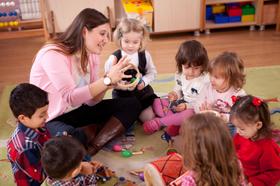A growing number of researchers are discovering that younger children’s access to early education leads to an enhanced ability to read and cognitively perform more effectively throughout their lives. Subsequently, many public schools are considering new programs that require kindergarten students to attend classes for a full day.
Traditionally, these younger students were slowly introduced into the academic world with only half or partial day classes; however, as more schools implement these programs, both educators and parents are forced to evaluate the many pros and cons of this rising trend.
The following video from the AMSD 2013 Annual Conference discusses how to prepare for the transition from half-day to full-day kindergarten.
The Current Public School Dynamic
Nationally, according to the Education Reporter, 31 states increased their funding in 2006 for early elementary programs. In addition, “…in 2007, at least 40 state legislatures have considered preschool programs and full-day kindergarten initiatives.” Specifically, “Legislators in Connecticut, Indiana, and Rhode Island proposed bills in 2007 to require school districts to offer full-day kindergarten,” while “At least eight other states have considered reimbursing schools that offer voluntary full-day kindergarten.” While many areas are promoting these new full-day agendas, many individuals are torn on the various arguments of this heated debate.
The Pros of Full-Day Kindergarten Instruction
Children enjoy long-term academic benefits
As the Milton View explores in their article, “Full Day Kindergarten,” data and research presented to the Milton School Board revealed that a full-day of kindergarten will academically enrich and benefit children. As the data reveals, “Children who attend full-day kindergarten learn more in reading and math over the kindergarten year than those in half-day programs.” The following video explains the differences between half-day and full-day kindergarten.
With this cognitive and academic focus, the Milton research advocates for longer kindergarten hours. Additionally, when examining the various components of classroom behavior and social abilities, “Full-day kindergarteners exhibit more independent learning, classroom involvement, productivity in work with peers and reflectiveness than half-day kindergarteners.” Essentially, according to reports, when children are engaged in a half-day program, they tend to spend less time on self-initiated tasks, activities, and lessons; therefore, when students are able to engage in a full-day of instruction, they are able to participate in more independent study/learning tasks, as there is less time devoted to whole-group instruction, and more time focused on independent development and learning.
Full-day programs close the achievement gap
Adding to these studies, the Milton View also reports that the Milton School Board research and analyses reveal that a full-day kindergarten experience can help ameliorate and close the achievement gap. According to reports, “At-risk students who received full-day kindergarten through Montgomery County, Maryland’s Kindergarten Initiative made significantly greater progress in language proficiency than comparable children in half-day kindergarten.”
Adding to this, a study that focused on the approximately 17,600 children in Philadelphia revealed: “Full-day kindergarten helps children from low-income families perform better and saves the school district millions of dollars through significantly reduced grade retention in first, second and third grade.”
As the Milton View adds, the research on these statistics is staggering. It seems as though study after study promotes this concept of full-day kindergarten, as the students who come to school from lower-income and financially struggling families are provided with extensive opportunities to close the gap between their own backgrounds with their financially-comfortable peers. Adding to the Milton Board of Education information, the “Extended Kindergarten Feasibility Study” also reports: “The research clearly indicates that Full-Day Kindergarten is highly successful at significantly reducing disparities in academic readiness as children enter the crucial two years of Grades 1 and 2.”
Students can overcome existing cognitive set-backs through full-time instruction
In addition to the research that reveals all students, regardless of social and economic background, demonstrate improvement from full-day kindergarten programs, it has also been reported that children in an elementary school in Albuquerque, New Mexico, were able to recover from a significant academic and cognitive set-back through full-day programs. According to this study, “The average entering kindergartener was already 22 months below grade level,” however, when comparing modes of instruction, “Children in the school’s half-day kindergarten made an average gain of 5.4 months during a 9 month period, while children in the full-day classes made a 16 month gain on average.” Remarkably, students in a full-day program were able to function with abilities almost 50 percent greater than that of their half-day peers.
The Cons of Full-Day Kindergarten Instruction
Studies do not address long-term holistic results
While the majority of information regarding full-day instruction is incredibly positive, there are still valid concerns resonating in the minds and instincts of both educators and parents. Foremost, as the “Extended Kindergarten Feasibility Study” argues, many of the positive claims of full-day kindergarten have not been evaluated for holistic student success: “Long term maintenance of gains are still being studied. But there is no simple fix to the achievement gap. Like most difficult challenges it requires multiple initiatives-- by the schools, by students and by parents—each of them necessary to achieving success.” While many reports advocate that the full-day model will ameliorate the disparities between the social and financial classes, these connections are still theoretical. This video looks at the advantages and disadvantages of ful versus half-day kindergarten.
Funding for full-day programs in public schools are limited
Adding to this, the full-day kindergarten program is incredibly costly, and many schools have not established confident plans for fiscal support. As the Milton View explains, “The Administration's modest request for funding a pilot program […] was cut […] because the total budget increase was judged to be too high.” Additionally, as Republican State Senator Bob Beers of Las Vegas announced in a press release, many full-day programs do not assist students who are not at risk, and/or who are not economically struggling. According to reports from the Education Reporter, “Among students who did not receive free or reduced lunch, full-day kindergarteners scored three points below their half-day counterparts.” As the author further explains, “‘There's too much emphasis on public relations and spin […] They've always attempted to mislead the Legislature, but this is the first time they've done it with hard numbers that we forced them to give us.”
The debate continues to heat up regarding full-day education, with research pointing to benefits and drawbacks on each side. If your school district does not offer a full-day program, but you want your child to reap the potential benefits, then consider supplementing the half-day program with your own curriculum, easily found at teacher’s stores and public libraries.
Questions? Contact us on Twitter. @publicschoolreview













